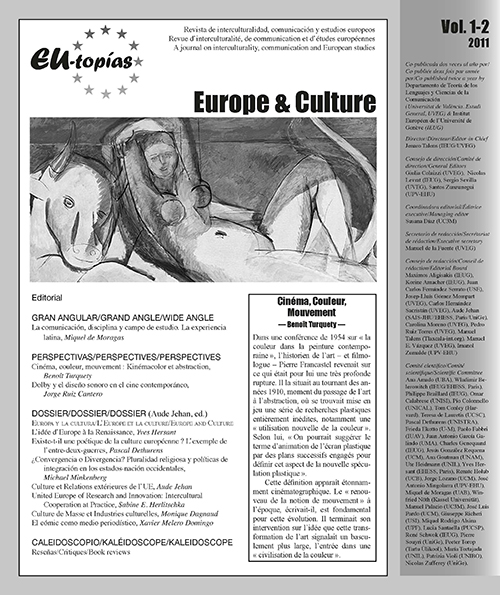Dolby et la conception sonore dan le cinéma contemporaine
DOI :
https://doi.org/10.7203/eutopias.1.18438Mots-clés :
Dolby, conception sonore, son cinematographique, Nouveau Hollywood, Walter Murch, Ben Burtt. Résumé
Résumé
Les quarante dernières années ont été une étape de progrès continu pour le son cinématographique, pas seulement du point de vue technique ou esthétique, mais aussi grâce à l’importance grandissante de la bande son dans le processus de conception et production des films. Cet article analyse l’influence décisive des technologies Dolby dans ces transformations et ébauche ses perspectives futures d’évolution.
 Téléchargements
Téléchargements
 Références
Références
BECK, Jay (2008). “The Sounds of ‘Silence’. Dolby Stereo, Sound Design, and The Silence of the Lambs”, en Jay Beck y Tony Grajeda (eds.), Lowering the Boom. Critical Studies in Film Sound, , pp. 68-83. Baltimore: University of Illionis Press.
CHION, Michel (1993). La audiovisión. Introducción a un análisis conjunto de la imagen y el sonido. Barcelona: Paidós.
Dolby (2010). “The Evolution of Dolby Film Sound” [En línea]. Disponible en <http://www.dolby.com/uploadedFiles/zz-_Shared_Assets/English_PDFs/ Professional/53_ EvolutionOfSound.pdf>. [Consultado 25 enero 2011].
HANDZO, Stephen (1985). “A Narrative Glossary on Film Sound Technology”, en Elisabeth Weis y John Belton (eds.), Film Sound, pp. 383-426. New York: Columbia University Press.
IOSONO (2010). “The Technology” [En línea]. Disponible en <http://www.iosono-sound. com>. [Consultado 20 enero 2011].
KASSAB, John (2009). “Report to investigate creative, technical and workflow innovations in post-production film sound in London, New York, San Francisco, Los Angeles and Wellington” [En línea]. Disponible en <http//www.churchilltrust.com.au/site_media/fellows/ 2009_Kassab_John.pdf>. [Consultado 20 enero 2011].
MANCINI, Marc (1985). “The Sound Designer”, en Elisabeth Weis y John Belton (eds.), Film Sound, pp. 361-368. New York: Columbia University Press. Publicado originariamente como «Sound Thinking» en Film Comment 19.6 (Noviembre- Diciembre 1983), pp. 40-43, 45-47.
MURCH, Walter (2000). “Stretching Sound to Help the Mind See” [En línea]. Disponible en <http://filmsound.org/murch/stretching.htm>. [Consultado 21 enero 2011].
MURCH, Walter (2007). “Touch of Silence”, en Larry Sider, Diane Freeman y Jerry Sider (eds.), Soundscape. The School of Sound Lectures 1998-2001, pp. 83-102. London: Wallflower Press.
PETROSKY, Max (2010). “Tron Wiki: Frank Serafine Interview” [En línea]. Disponible en <http://tron.wikia.com/ wiki/Tron_Wiki:Frank_Serafine_ Interview>. [Consultado 21 enero 2011].
SCHREGER, Charles (1985). “Altman, Dolby, and the Second Sound Revolution”, en Elisabeth Weis y John Belton (eds.), Film Sound, pp. 348-355. New York: Columbia University Press. Publicado originariamente en Film Comment, 14, nº 5 (Septiembre-Octubre 1978). Título original: “The Second Coming of Sound”.
SERGI, Gianluca (1999). “The Sonic Playground. Hollywood Cinema and its Listeners” [En línea]. Disponible en <http://www.filmsound.org/articles/sergi>. [Consultado 24 enero 2011].
SERGI, Gianluca (2004). The Dolby era. Film Sound in Contemporary Hollywood. Manchester & New York: Manchester University Press.
SHATZ, Leslie (2001): “The Dolby Film Sound Revolution: Looking Back and Looking Forward with Audio Pioneer Ioan Allen” [En línea]. Disponible en <http://www. editorsguild.com/v2/magazine/Newsletter/SepOct01/ioan_allen_one.html>. [Consultado 24 enero 2011]. Reimpreso de The Motion Picture Editors Guild Magazine. Vol. 22, No. 4 – September/October 2001.
TURNER, Nick, y Tom Giles, (eds.) (2010). “Pixar Gets Dolby to Invent ‘Rain of Sound’ to Match 3D Movies” [En línea]. Disponible en <http://www.sfgate.com/cgi-bin/ article.cgi?f=/g/a/2010/05/22/bloomberg1376-L2SL460YHQ0X-1.DTL>. [Consultado 12 junio 2010].
WHITTINGTON, William (2007). Sound Design and Science Fiction. Austin: University of Texas Press.
Téléchargements
Publiée
Comment citer
-
Résumé543
-
PDF (Español)404
Numéro
Rubrique
Licence
![]()
Tous les contenus publiés dans EU-topías. Revista de Interculturalidad, Comunicación y Estudios Europeos est sous licence Creative Commons Paternité-Pas d'Utilisation Commerciale-Partage des Conditions Initiales à l'Identique 4.0. Le texte complet de la licence peut être trouvé à http://creativecommons.org/licenses/by-nc-sa/4.0
Ils peuvent être copiés, utilisés, diffusés, transmis et affichés publiquement, à condition que:
- L'auteur et la source originale de la publication sont cités (magazine, éditeur et URL de l'œuvre).
- Ils ne sont pas utilisés à des fins commerciales.
- L'existence et les spécifications de cette licence d'utilisation sont mentionnées



